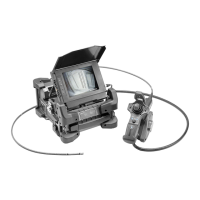What to do if Olympus Analytical Instruments shows 'IMAGER ERROR'?
- AAndrea PriceSep 8, 2025
If you encounter an 'IMAGER ERROR' on your Olympus Analytical Instruments, stop the inspection and turn the instrument off, then on again.

What to do if Olympus Analytical Instruments shows 'IMAGER ERROR'?
If you encounter an 'IMAGER ERROR' on your Olympus Analytical Instruments, stop the inspection and turn the instrument off, then on again.
How to improve image brightness on my Olympus Analytical Instruments?
If the image brightness is not optimum on your Olympus Analytical Instruments, configure the proper setting by performing the [BRT] lever operation. Check if the objective lens on the insertion tube's distal end or the optical adapter is dirty and clean it. Also, ensure that the external monitor is correctly adjusted and the optical adapter is properly attached. If the optical adapter is old, consider replacing it.
What to do if I get an 'OVER CURRENT (USB)' error on my Olympus Analytical Instruments?
To resolve the 'OVER CURRENT (USB)' error on your Olympus Analytical Instruments, first, power off the instrument and then turn it back on. Ensure you are using a recommended USB flash drive. If the issue persists, disconnect all USB devices except the flash drive, as other connected devices might be causing the overcurrent.
What to do if my Olympus Analytical Instruments says 'NO RECORDING MEDIA'?
If your Olympus Analytical Instruments displays 'NO RECORDING MEDIA', load the USB flash drive and try again. If the problem persists, turn the instrument off, then on again.
What to do if Olympus Analytical Instruments shows 'HIGH TEMPERATURE (DISTAL END)'?
If you get a 'HIGH TEMPERATURE (DISTAL END)' message on your Olympus Analytical Instruments, immediately pull the insertion tube out of the observation object.
What to do if I get a 'RECORDING MEDIA ERROR' on my Olympus Analytical Instruments?
To resolve a 'RECORDING MEDIA ERROR' on your Olympus Analytical Instruments, format the USB flash drive directly on the instrument.
How to fix a blurry image on my Olympus Analytical Instruments?
If the image from your Olympus Analytical Instruments is not sharp, try wiping the objective lens on the insertion tube's distal end or the optical adapter with a clean piece of gauze or a cotton swab. Ensure the optical adapter is properly attached and that the external monitor is correctly adjusted.
Why is the operation load for articulation getting heavier on my Olympus Analytical Instruments?
If you are experiencing heavy operation load for articulation with your Olympus Analytical Instruments, the angulation lock might be engaged. Press down the [ANGLE LOCK] lever to release the angulation lock.
What to do if Olympus Analytical Instruments shows 'HIGH TEMPERATURE (MAIN UNIT)'?
If you see a 'HIGH TEMPERATURE (MAIN UNIT)' message on your Olympus Analytical Instruments, it indicates the main unit is overheating. Stop the inspection, allow the instrument to cool down, and then turn the power back on.
What to do if Olympus Analytical Instruments shows 'IMAGE CAPTURE ERROR'?
If you encounter an 'IMAGE CAPTURE ERROR' on your Olympus Analytical Instruments, stop the inspection and turn the instrument off, then turn it on again.
| Model | IPLEX IV9420RX |
|---|---|
| Category | Industrial Videoscope |
| Insertion Tube Diameter | 4.0 mm |
| Working Length | 2.0 m |
| Field of View | 90° |
| Minimum Observation Distance | 3 mm |
| Light Source | LED |
| Operating Temperature | -10°C to 40°C |
| Storage Temperature | -20°C to 60°C |
| Direction of View | Forward |
| Image Sensor | 1/6 type color CCD |
| Battery Life | 120 minutes |
Highlights crucial safety warnings and symbols used throughout the manual.
Provides essential safety rules for handling the instrument and its components.
Explains the meaning of hazard symbols and associated risks for safe operation.
Outlines initial preparation steps before commencing observation, including power setup.
Details the sequential steps for preparing the instrument before operation.
Provides instructions on how to correctly attach the optical adapter to the insertion tube.
Step-by-step guide on how to view an object using the instrument.
Covers formatting the USB flash drive and understanding image capacity.
Step-by-step guide on navigating and using the instrument's menu system.
Introduces the stereo measurement function and prerequisites like optical adapters.
Provides a visual guide to the sequence of steps for stereo measurement.
Details the correct method for attaching the stereo optical adapter and important cautions.
Step-by-step guide to register a new stereo optical adapter with the main unit.
Explains how to select a registered stereo optical adapter and confirm its details.
Details how to check measurement accuracy before and after performing measurements.
Guides on observing the measurement area and selecting display modes for optimal viewing.
Explains how to use spot ranging to measure the distance to the measurement area.
Guides on selecting the appropriate measurement method (e.g., distance, depth).
Details how to specify measurement points and reference points for accurate measurements.
Explains the various components and indicators displayed on the measurement screen.
Describes different measurement methods including distance, point-to-line, and depth.
Guides on how to move the cursor and specify measurement points on the image.
Covers procedures for replacing the battery and O-ring for instrument upkeep.
Details how to clean the insertion tube, distal end, and optical adapter.
Lists common error messages and provides solutions for resolving them.
Addresses problems related to illumination not working and optical adapter attachment.
Explains how to request repair services and details warranty considerations.
Outlines specifications related to the stereo measurement function, including measurement types.











